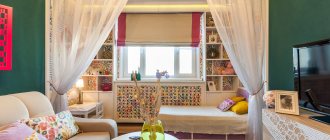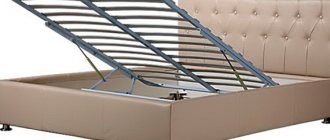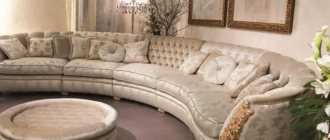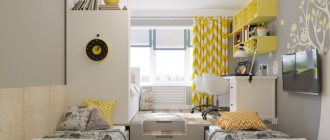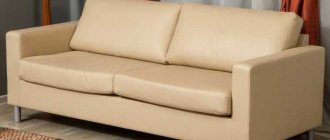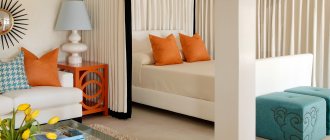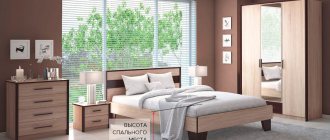How to arrange a living room with a sleeping place
When planning the furnishings when combining a living room and a bedroom, you must proceed from the area of the room. Actually, there are several ways.
- Do not delimit the space, but use transformable furniture. In particular, a bed built into a closet or a sofa bed, but not in the old version, but in the new one (one example is shown in the photo). One of the options for equipping a living room-bedroom in one room
- Separate the space for the bed by separating it with a stationary or sliding partition.
- Separate the bed with a screen or curtains. One way to highlight the bedroom area in the living room is a partition, but not at full height
This is a view from the living room towards the bedroom - Use furniture (wardrobe, shelves, etc.) for zoning.
If the living room and bedroom are small (less than 16 square meters) or it is not possible to install a bed and sofa due to the layout, there is only one solution - to use transformable furniture. If the area allows, you can use any of the methods.
Zoning options
Before arranging the bedroom-living room, you need to choose a place to sleep. Let's analyze possible zoning options:
- The sleeping place is placed away from the door. It is better to place the bed next to the window, on the opposite side from the entrance.
- Many people rightfully consider the bedroom a personal space where a person should feel safe and calm. The design of a living room with a bed and a sofa is developed taking into account the wishes of the owner, the presence of a partition is implied. The lack of natural light is more than made up for by floor lamps, spotlights and wall lamps.
- If the area is large, delimitation is allowed using a plasterboard partition. By installing a wall to the ceiling, a small bedroom is created. The disadvantage of such zoning is that light does not penetrate into the guest room. If you install a partition halfway up the ceiling, this will not interfere with sunlight and ensures isolation of the bedroom.
- The space is divided by a matte partition, which clearly demonstrates the line between the functional zones.
- Zoning of such a living room is possible using sliding curtains. Thick curtains will provide privacy, while light ones will highlight the edge of the bedroom, while maintaining the holistic significance of the room. Curtains made from faceted glass beads look interesting and unusual.
- Installing a bed in the living room is possible thanks to the use of sliding partitions that will not overload the space. The width of the partition may vary. Mobile screens allow you to change the area, increasing the living room or reducing the bedroom. When guests arrive, the entertainment area expands, then the partition returns to its original position.
- You can zone a small living room using a shelving unit without a back wall, which is used to save things dear to your heart. This design does not interfere with the penetration of sunlight.
- Zoning a room is possible through visual effects: different flooring structures, contrasting walls, etc.
- A small podium with built-in drawers allows you to highlight a sleeping area.
- The division of space is also possible through original lighting methods. For example, you can dim the lights in the bedroom and brighten them in the living room.
When creating areas where a sofa and a bed are located in the same room, you should pay special attention to the design to maintain the overall style of the room.
How to divide a room into zones
To decide whether you can have two separate zones in the room or not, you need to first evaluate everything on the plan. This can be done in design programs that allow you to obtain a two or even three-dimensional image. If working with programs does not seem attractive to you, you can get by with two sheets of thick paper or cardboard.
One of the programs...
To evaluate zoning options manually, you will need a floor plan with dimensions drawn to scale. Display on it where the windows and doors are located (also with dimensions). Next, you need to think about where you would like to place the bed, where is the sofa for guests. For the living room-bedroom, these are the two key items that they try to put first. It is better to cut them out of cardboard, and also to scale. You will also need to cut out from cardboard the furniture that is necessary and must be there. If you don't have one yet, cut them out in the sizes you want. Then you can make adjustments.
On paper it looks something like this
The resulting set of “furniture” can be moved according to the room plan, finding possible options for the location of zones. If there are several options, sketch, sign where and what you will put, putting down the dimensions of the furniture and the passages between them. Then it will be possible for everyone to think about what type of zoning can be applied in each option. The program works approximately the same way, only the movement is virtual. Using a program or layouts, you will understand whether you can select two separate zones, while determining the size of each of them. If it is not possible to separate separate zones, you will have to make do with folding furniture.
When are two sofas better than one?
- If your living room has a lot of windows and doors, then it will be much more difficult to create a suitable design for it, since it will be very difficult to find space for one sofa, let alone several. The situation will be even more complicated if this room is central in your home, where the whole family will gather to relax, watch TV and receive guests. But it is in this case that it is worth considering two sofas in the living room interior. They should be small in size and placed in the center or close to the center of the room - this will allow clear passages to windows and doors.
- A popular technique that designers like to use, especially in small apartments, is to zone a room by using a sofa. Using only one sofa, which is located at the junction of these zones, is not very convenient, especially if it is not possible to mount a TV opposite. And if the upholstered furniture is large, this can close the free passages on the sides. A living room design with two sofas can easily save this situation. Choosing these two pieces of furniture in sizes that will match the size of the room and placing them perpendicular to each other will free up space and create a unique design for your living room.
- There are times when a room needs symmetrical balance. This technique is used in classic and modern interiors. To create perfect symmetry, you need to place two sofas in the room along an axis that should extend from the compositional center. This layout will look very good in an interior of any style, because mirrored furniture in the center of the living room will create a background with ideal order, which will allow you to experiment with the rest of the room’s decor.
Solution for small rooms
Arranging small rooms requires a special approach. Creating an interior is an art, and the design of a small room, and even a multifunctional one, is generally akin to circus art. Even the little things are important here.
For a small living room bedroom you need to think through everything to the smallest detail
Let's start with what is considered a small room in this case. In general, it is believed that a room with an area of 14-16 meters is rather large. But in the case of the need to accommodate two zones - a living room and a bedroom - this is really very little. These are the types of rooms - up to 16 square meters - and we will accept them as small ones. If the area is 18-20 meters or more, these are already “normal” sizes in which the living room and bedroom can be divided using any zoning techniques.
Using customizable furniture
In a small room, it is not always possible to combine a living room and a bedroom, while installing a full-size bed. But you can always put a transformable sofa instead of a regular sofa. This is not a sofa bed on which you can only sleep conditionally. Modern transformable furniture can provide the same level of comfort as a regular stationary bed. There are models with orthopedic mattresses. Width ranges from single to full double.
Wardrobe that turns into a bed
Can be converted into a double bed:
- Closet. When closed, it looks like an ordinary wardrobe; it folds back and becomes a bed.
- Sofa. This type of furniture in the “day” position is similar to a sofa that stands near the closet; in the “night” position, the bed lowers, crushing the sofa under itself.
The options described above require a free space of at least 220-250 cm in front of the sofa or closet (depending on the model). And after the bed is in place, there should be at least a narrow passage left. So, in fact, the distance to the transformable furniture should be at least 280 cm. But you get a full-fledged double bed. The mattress can even be orthopedic.
This is an interesting transformation
There are also options for single or single beds. In them, the base of the bed is attached to the furniture with the long side. They require less free space - no more than 200 cm in the case of a one-and-a-half bed or 150 cm in the case of a single bed.
Unusual ways
There is one non-trivial option for how you can highlight the bedroom area in the living room: make a podium on which to place some area. There you can place, for example, several armchairs and a coffee table or place a sofa. Push the bed under the podium.
Make a podium and roll up a bed under it for the day (you can make a chest of drawers from the steps)
With this solution, the flooring must be of sufficient height so that the bed can be hidden under it. Long and narrow rooms, also called trailers, are ideal for this solution.
Another option for the young and active: move the bedroom to a closet. A square or rectangle of sufficient area to accommodate a sleeping place is assembled from cabinet furniture (high shelves, cabinets). You can do this using plasterboard partitions (as in the photo). On one side a staircase is built in/attached, along which one climbs up “to the bedroom”.
Here's an unusual way to separate the living room and bedroom
It turns out to be a living room-bedroom without reducing the living room area. You can even make the room even more multifunctional: arrange a workplace or mini-office in a space fenced off with furniture. This is an excellent option for a small studio apartment where young people live.
All this is not bad, but it is worth knowing about the disadvantages. First, the solutions are not cheap. Transformable furniture costs a lot, as does making a podium with sufficient load-bearing capacity. Secondly, every evening and every morning, in order to get and hide a sleeping place, you will have to make certain body movements. This only seems easy at first. In fact, it gets boring pretty quickly...until it becomes a habit.
Choose a place for the sleeping area
When dividing rooms into a bedroom and a living room, first of all you need to decide where you want to make the bedroom. Most often, the corner farthest from the entrance is chosen. This makes sense, since the bedroom requires the greatest degree of privacy.
If there is a window in the separated area, you will have to make sure that there is enough light in the rest of the room. Glass partitions, separation using screens or curtains, specially created translucent shelves help with this.
The bed in the living room with a separate bedroom is usually placed further away from the entrance
In the opposite situation - if the window is in the living room area, the situation is slightly better. Firstly, the bedroom is usually used at night. So natural light is not such a necessity. Although we are accustomed to the fact that it should be. There are two solutions: make the division so that there is enough light or get what is missing by installing additional lamps.
Zoning space for two sofas
Why is zoning needed? To improve the functional characteristics of a room or to develop a new design approach. Using a sofa to zone a living room is very easy, but using two sofas it’s simple and effective. Several items can evenly distribute the living room into equal parts or into an intersecting room, it all depends on the footage, layout and creativity of the decorator.
The room should be large enough so that, in addition to upholstered furniture, other items can be placed in it
There should be sufficiently free passages between pieces of furniture.
A design with two sofas is more productive for a number of reasons:
- creates more seats;
- Convenience of communication on the contrary;
- rational use of quadrature;
- Fashionable style.
For example, in the famous movie “Friends” everyone remembers the interior of the living room. When watching a movie, the thought always appears that some detail is missing from the home. Please note that the photo is missing two sofas in the living room.
The famous living room in Monica's apartment
If there is one sofa in the living room, it is not always more spacious than if there are two. Proper division of the room into zones with two sofas gives more space to move and affects the seating area.
The presence of two sofas in the room significantly expands the relaxation area
Before buying sofas, you need to decide on the arrangement of furniture in the living room.
Zoning the living room-bedroom with partitions
For zoning, partitions made of plasterboard and glass are used. The installation of both is not a redevelopment, so it does not require approval.
Not everyone likes the idea of putting a room divider. But it may not be whole. Very often, a “monolithic” partition is erected to a height of a meter or a little more, and above that they make something openwork that allows light to pass through. This solves the problem of natural lighting and the structure does not look as heavy as a wall.
Partitions - they are different
Also a good way to isolate a bed
Openwork things are made from plasterboard
Also an option
The upper part can be designed in different ways. If you want physical separation, but without much loss of light, it could be patterned, frosted, colored glass. Do not be afraid that the glass partition is fragile - it can withstand loads greater than drywall.
Other options: various types of wood and metal products. There are a lot of options - from functional or decorative shelves, to pins made of wood, metal, bamboo, etc. simply installed in a certain order (or without it).
Separating zones with screens
You can create zoning in the living room and bedroom using screens. This is a quick and inexpensive way to zone the living room and bedroom in one room. Do not think that this method is outdated and irrelevant. If you choose the right textures, materials, colors, everything looks very stylish, original and appropriate.
Option for a translucent partition for zoning the living room and bedroom
A portable screen can be stylish
You can even use a rope curtain as a screen. The main thing is the visual delimitation of space Light mobile curtain
Openwork is good in classic interiors
There are traditional screens - portable, folding. But it is far from necessary that they have an “old-regime” appearance. No, traditional-type screens - covered with tapestries - are good for classic interiors. And those that come from the “sixties” - painted, made of wood and plywood - look great in a loft or art deco. If your living room or bedroom is decorated in this style, it will not be difficult for you to find the right option. But modern interiors require other materials and textures, and here you will have to try.
Glass screens
Glass screens are ideal for modern style, minimalism, and hi-tech. It’s just that you have to choose different glass. For hi-tech and minimalism, the best option is tinted with a silver coating, reminiscent of a mirror. White, milky, gray will look good - depending on the design of the bedroom-living room. A living room bedroom in Provence style can also be equipped with a screen made of painted plywood. But if you don’t like a too “rural” option, you can add a glass screen with photo printing. You can choose one of the landscapes that are typical for the south of France, use colored glass with floral patterns.
The frame is made of metal, the filling is frosted glass or sheet polycarbonate
Milk glass is opaque, but allows enough light to pass through
A look from the other side
Interesting option with patterned glass
Traditional glass sliding screen
Patterns are applied using a sandblaster
And again, don’t think that glass is fragile. For such products they use hardened or laminated (duplex and triplex), and they are stronger than many sheet materials.
From other materials
If you still don’t like glass, you can make or look for partitions made of plastic, wood, etc. You can make a wooden screen into a wooden house. If you know how to work with wood, this will not be difficult, since the design is simple. You can imitate a wall, you can make a lighter, openwork design. Again, everything depends on the style in which the living room and bedroom are decorated.
A patterned plastic partition visually separates zones from one another
The simplest wooden screen made of rods or planks
Carved wood panels require more skill
Metal openwork….
If wood is only found in some decorative items, frames are made from it, and the filling is selected according to your own taste. After all, it could be fabric. The same as on curtains or upholstery. You can use fiberboard laminated to match the furniture, plywood or thin chipboard. You can even assemble such a screen from drywall and cover it with wallpaper or paint it - it will be a movable wall.
For a modern style, you can use well-aimed branches painted in the main or one of the additional colors. They are attached to frames along or across to create a translucent screen. Bamboo, metal rods, etc. can be secured in the same way. In general, as usual in interior design, this is a creative process.
Sliding screens
A few more words about sliding screens. They are in a separate class, since they are not as “nailed into place” as stationary partitions, but also not as mobile as portable screens. A very good option for zoning the living room and bedroom into one room if you want to have a secluded corner for relaxation.
Sliding screens can be of three types. They can move like sliding doors, fold like a book or an accordion. For all of them, the bottom needs guides that are attached either to the ceiling, or to the floor, or to both the floor and the ceiling at the same time. Only screens with a bottom guide can not reach the ceiling, but they are the most unstable. If you have children or are not sure that you will use them carefully, it is better to use floor-to-ceiling models.
Sliding screens are made like compartment doors
Living room bedroom with separation of zones using sliding screens
With a slight touch of oriental style
Geometry always looks good
The material for screens of this type is any sheet: glass, plastic, laminated fiberboard, MDF. You can look for similar systems in companies that deal with sliding wardrobes. Doors for sliding wardrobes are made using the same system and partitions are no different.
Ways to play up two sofas and color plans
If you still decide to use two sofas in your living room, then remember that they should not be absolutely identical. Their style, size and even color may differ from each other, but do not forget, whatever their differences, they must be in harmony with the surrounding stop. In order to visually equalize the size of the sofas, you can add a small table or chair next to the shorter one. When designing a living room plan, pay attention to the balance of the entire room, balancing all its parts. One part should not be overloaded, and the second should not look empty. To highlight the center of the living room, where the sofas are located, you can place a rug under them. It can be bright or neutral, but it must fit into the interior and contrast with the flooring. Coffee tables can be a great addition, as placing one in the center of the room may not be enough. They can be placed on the side of sofas or between them. When choosing the color of sofas, it is recommended to focus on light, pastel and neutral shades, but depending on the design of the room, you can add bright armchairs or use eye-catching decorative items.
When buying upholstered furniture, you should pay attention to three important things: comfort, quality and color. Designers identify five main color plans that will allow you to correctly combine the furniture with the rest of the room.
- Monochrome. In this interior, the sofa and walls are made in the same color, but in different shades. For example, if the walls are painted beige, then the sofa upholstery is brown, and lilac walls are complemented with purple furniture, and so on.
- Neutral. The walls and sofa have neutral shades, but they can be different. For example, you can add pale blue furniture to gray walls or the timeless classic - white walls and a black sofa.
- Neutral and bright. In this case, designers choose upholstered furniture in a neutral shade, but place it in a bright interior, which will balance it and create color balance.
- Bright and neutral. This design, on the contrary, is characterized by the use of bright sofa upholstery and neutral wall colors. This will add a splash of color to a monochromatic and boring interior.
- Combined. A bold and rich sofa is added to the bright walls. In order to use this option, you need to clearly understand the combination of colors and their shades. Purple walls and dark green furniture or a blue sofa against a red background will look good.
Each of these options can be complemented with decorative pillows, which can become a link between all the colors and the overall decor of the room. Think about how you want your sofa to look - calm and neutral or bright and catchy. For individuals who love comfort and relaxation, the first two options are suitable, and for creative people who do not like to sit still, the remaining three will be the ideal solution. Please note that the combined plan is the most difficult to implement, so it is better to consult with a specialist before choosing it.
Remember that the sofa plays an important role in creating comfort and coziness in the apartment, so you need to be very careful when choosing it, especially if you plan to use more than one such piece of furniture. In order for it to serve you for a long time, choose high-quality upholstery and do not be lazy to care for it.
We hope this article answered all your questions and helped you understand that two sofas in the living room interior are not only an excellent opportunity to create a unique room design, but also double comfort for your entire family.
How to arrange two sofas in the living room is a question for those who decided to furnish this main room of the house with the help of two pieces of upholstered furniture (sofas). The sofa in the living room is often given the main place and all other furnishings are located “around it”. We will look at how to correctly position two sofas in different interior styles, how best to place them, how to choose the right upholstery color and shape.
Choice of sizes and colors
Living room furniture should be chosen after the design has been thought out. It is necessary to take into account all the little things: furniture arrangement, color design, texture of finishing materials. After this, you can buy furniture, including sofas. Here are some tips to help you make the right choice:
- You need to decide on the size of the furniture. It depends on the size of your premises and the number of guests you are used to receiving.
- You can buy this piece of furniture in numerous showrooms, where a huge assortment is provided. There is an option to order upholstered furniture if you want exclusive samples.
- When choosing a color, remember that sofas do not have to be the same color as the room. Contrasting options with an emphasis on sofas will look great.
Pay attention to upholstery and functionality
An attractive option would be the following choice: two sofas in the living room, different in shape and design. You can purchase paired modules. They will fit well into small living rooms, and you can experiment with sizes. As an option, you can buy transformable sofas. Modern models will save space during the day and fold out when you need to rest.
The upholstery material is important when choosing. It can be completely different: suede, leather, velor, jacquard and tapestry. The most popular are tapestry, flock and velor. But these materials are not as durable as jacquard and chenille. The latter are more expensive, but not much. But the service life of such sofas will please you. Their leather samples look great, but they are expensive. You can choose products made from artificial leather, the quality of which is not inferior to natural leather, but much cheaper.
Upholstery should also be chosen according to the color preferences of the owners and in accordance with the overall design style of the room. Materials of the same texture can look completely different in different colors. Therefore, you need to look at several options to make a choice.
Placement of two sofas
There are several options for placing two sofas in your living room. We hope that you will find what you need from the following:
- Placement with the letter "G". Convenient, beautiful and gives guests the opportunity to watch TV.
- The sofas are opposite each other. This involves guests relaxing and socializing without TV. Perfect for various discussions and games.
- Installation along the wall or in the center one after another. This option allows you to free up a lot of space. But to complete the composition, it should be supplemented with other soft structures.
A large assortment of multifunctional upholstered furniture often leads to spontaneous purchases, after which there will be a problem of combining different sofas in the interior. This could be a home or office, a living room or a one-room apartment, a large apartment or a studio apartment. Often it is necessary to purchase not chairs, but to increase the number of seats. In any online store you can choose small-sized products that will complement previously purchased sofas to create a stylish interior. But what if these sofas are so different?
Zoning with curtains
An even more inexpensive way is to have a living room/bedroom divided into zones by curtains. All that is required is to select and secure curtain rods. Then select fabrics and sew panels of the required sizes. The fabrics used are the same as for windows and they do not have to be thick, although this option is possible.
Curtains can be without folds - in the Japanese style. Draperies around the perimeter - to create coziness. Visible division
Double curtains - it is important to choose the right curtain rods
The drapery can cover only the “clearance”, or it can also go along the walls, creating a cozy atmosphere. But this option will still require quite a bit of money, since you need a lot of fabric.
Such zoning of the bedroom and living room combined in one room is nominal, but creates the required feeling of privacy. It can be used in the version with portable screens as a temporary option - if you just can’t decide where exactly to place the bedroom and living room areas, or how to distribute the area between them.
Using furniture to separate
It is not always possible to allocate even a small piece of space in a small room under a non-functional partition. Moreover, furniture can perform the same task. Usually this is a closet or high shelves.
Most often, the lower part of the furniture is made without gaps (about a meter high). I make this part in the form of a cabinet or chest of drawers. The top one is usually made with through gaps. This way the furniture doesn’t look so bulky and doesn’t “clog” the space. In addition, this solution allows you to maintain natural light in both parts of the room.
A cabinet or chest of drawers is made in the lower part, shelves are made above
Non-linear shape adds originality
A look from the other side
The main thing is not to clutter the shelves
When developing the concept of such furniture or looking for ready-made options, keep in mind that all horizontal surfaces collect dust well. Each shelf is a dust collector. If they are not planned to be used, it is better to make as few horizontal lines as possible. It is better to hang several decorative items in the spaces between the racks. They collect much less dust, and perhaps look more original.
Living room bedroom: additional zoning techniques
In addition to physical separation, zoning the living room-bedroom in one room can be done using:
- Changes in floor and ceiling levels. For example, the bedroom area can be raised a little, and to further emphasize the division, you can use different flooring. It can be the same in color, but different in texture or material. For example, lay laminate flooring in the living room area and carpet in the bedroom area. You can also use different colors.
Different wall colors are one of the means of zoning. So the living room and bedroom clearly have two parts with different purposes.
Separation by color
The podium is not small... but it can be 5-10 cm high
- Decorate the walls with different colors. You can use wallpaper of two colors, but with the same texture, paint it in a different color, etc.
- Different texture of the walls. In the living room, for example, there is decorative plaster of the Venetian type, in the bedroom there is liquid wallpaper.
These techniques will also help you zone your living room. But when choosing colors, you must be guided by the principles of color compatibility. Then you will be able to create a harmonious interior.
Living room-bedroom design: 6 types of space division
- Just a bed and a sofa in one room
- Construction of a partition
- Sliding doors on rollers
- All kinds of curtains and drapes
- Shelving and various translucent structures
- Screens
- The bed is located under the ceiling
Now let’s look at each method in more detail with illustrations and find their pros and cons.
Bed and sofa in the room
Not separated by anything. This is my favorite method because it allows you to better preserve the space of the room, air, light, volume. It can be used for any room proportions and any window arrangement. The main thing is to move away from the literal understanding of the concept of “space zoning”.
I strongly suspect that this term was brought to the masses by one TV show about repairs, where the editors understood it literally. In fact, it is not at all necessary to physically divide the room with something in order to get these notorious functional zones. The furniture itself, placed in groups in different places, already designates them. Sometimes it is enough to place a chair not against the wall, but in the middle of the room and it will separate the sofa and coffee group. You can also use a coffee table, pouf, etc. And two carpets, two light sources, etc. can additionally emphasize the zones.
Perhaps it’s generally worth choosing two chairs.
The same chair in the center of the room that I was talking about. It closes off the living space. Opponents of this method have an ironclad argument: the bed is an intimate place and it should be covered from view. Of course there is some reason for this. But personally, I think that a cleaned, made bed is no more intimate than a folded sofa bed. The forms are different, but the content is the same.
Construction of a partition
An option for those who still want to keep the bedroom area private, or get a corner for privacy. Typically, partitions are built from plasterboard or other lightweight material. It is more convenient to use if the room is elongated and has several windows on a long wall. If the window is at the end, then most likely this option will not work. Otherwise, half the room will not receive sunlight. But there is still one way, I’ll show you below.
Here the designer acts very unconventionally and uses glass partitions. Personally, I don’t really understand the functional load of such a wall, but I won’t argue with the fact that it’s beautiful :))) Light enters the bedroom, the separation, of course, is very conditional. And it costs a lot...
This is the very method that I promised to show. There is no more accurate illustration, but I think you can get the meaning. In the photo, due to the fact that there is no window in the bed area, the designer uses a non-standard move - he erects a low partition. As a result, both parts receive light, the space is not divided into tiny cells, and minimal privacy is ensured.
If you still don’t understand, then I’ll explain. In the same way, you can place a bed at the end window, and a sofa closer to the exit, separated by a low partition about one meter high.
Sliding doors on rollers
Essentially these are the same walls, but if necessary, the bed is completely hidden from view. I don't like this option due to the price. It might be easier and cheaper to choose something else.
All kinds of curtains and drapes
To divide the space of the room, mobile devices made of fabric are used, which can be easily opened and closed at the right time. Basically, this is just an economical version of sliding doors. A good solution when there is a need to temporarily hide the bed from prying eyes. It is very convenient when it is possible to place the bed in a recess like a niche. Advantages: low cost and mobility.
Shelving and various translucent structures
Here we say a huge thank you to IKEA. The Kallax rack (an old similar model was called Expedit) is an almost irreplaceable thing, with the help of which a room is very often zoned. Similar racks are available from other manufacturers. Other models will also fit. This option is convenient for elongated rooms when the window is located only on the end wall.
Thanks to its lightweight design, the shelving unit does not completely block the light and ensures privacy in the sleeping area. Plus this is additional storage space.
Zoning with a screen
Not the most common option. But if you have a beautiful screen, the solution is very aesthetic. It is also often used in elongated rooms with a window on a short wall. A screen is better than a shelving unit in that it is more compact and sleeker in size, brings uniqueness to the interior, and can always be removed if you get tired of it. The disadvantage is that the furniture is very exotic, there is a very small assortment, beautiful screens are completely inexpensive, although you can make a simple screen yourself.
If associations with a medical office don’t bother you, then this is quite an option.
